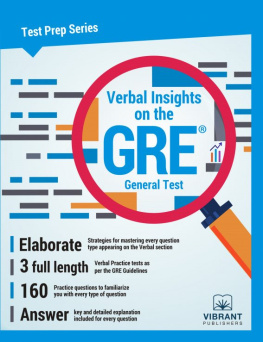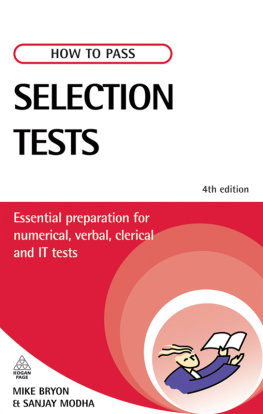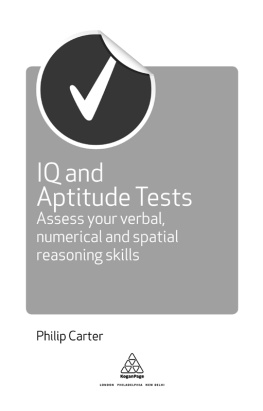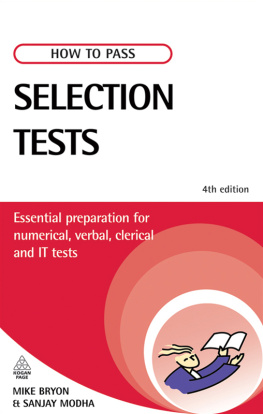Increase your IQ: 4000 Practice Questions and Exercises to upgrade numerical, lateral thinking, and English verbal skills
Eulalia Jenkins
Foreword
In the modern age, IQ tests have to be carefully prepared for, since they are of prime importance in the selection process for many jobs, and also because they are extremely good for your brain to go through a cycle of self-improvement and self-upgrade routines.
Through careful preparation and extensive drills, it is possible to improve your analytical and logical reasoning skills, and even to develop a systematic method to achieve lateral thinking in an unfamiliar situation.
Here are the main formats that you will encounter on the average IQ Test:
1. Simple arithmetic puzzles, with a twist: The level of mathematics you need to know to understand the questions on an IQ test is usually not above 7th grade. But IQ puzzles bring a creative twist to the tired old formulae of BODMAS or PEMDAS, and simple equation word problems. This book has many problems of this type.
2. Spatial IQ problems: These test your ability to visualize 3D shapes, for example, by giving you a custom made pair of dice, showing you a few faces, and asking you to guess the relative orientations of the other faces, by using your ability to extrapolate to higher dimensions given multiple views of an object in lower dimensions (in this case, 2D).
3. Pattern recognition: These can be either numerical or spatial (and sometimes even verbal!). They will give you a few segments of the changes in a visual or a series, and you have to work out the next element. Puzzles of the type where you are given a shape, with a dot inside it, and where the dot moves around from picture to picture - these are a great example of this type of question. Your aim is to predict the final position of the dot inside the shape.
4. Word Puzzles: These are of many different types, ranging from simple riddles that ask you to complete common words, to complex exercises where you have to unscramble the letters of a ten letter word to make another ten letter word. The only way to get better at solving these quickly is to practice a few different formats till you build up speed. This book will definitely help you!
5. Series completion quiz questions: These could be related to words, numbers, pattern recognition, or general knowledge. This book has a few problems of this type, as well!
No matter which of these puzzle types you are good at, and which you struggle with, this book will help you - through the example solutions, and through the detailed worksheet questions and solutions.
I am sure that you will learn many new things, and have a great time!
Table of Contents
Format 1: Tips and Tricks (Numbers and Operations)
If you were given the expressions:
5 + 4 + 3 + 2 + 1
and
5 - 4 - 3 - 2 - 1
and asked to tell me which was greater in value, your task would be easy!
5 + 4 + 3 + 2 + 1 = 15. 5 - 4 - 3 - 2 - 1 = -5. Clearly, 15 is greater than -5.
If the arithmetic operations allowed between the numbers can also include multiplication and division, and if the numbers are slightly larger, the task is not always so easy.
The concept of PEMDAS or BODMAS is first introduced to us in elementary school, but it is tricky even for many adults to completely master.
Here is an elementary summary:
In an expression that involves arithmetic operations of different types, always solve the division and multiplication parts first.
If you have to solve the expression:4 / 2 - 5 x 8You first solve the divison, to get2 - 5 x 8Next, you solve the multiplication, to get 2 - 40Finally, you solve the subtraction, to get:-38.
This is all you need to know to solve every problem in the upcoming section, but the questions I have for you have a small twist.
In each problem, you will be given five numerical expressions with operations scattered throughout them.
You have to evaluate each of them, and then arrange them in ascending order, from smallest to largest.
All this within a time limit that you initially set for yourself, but that you make increasingly more strict with each problem.
Have fun! The next chapter contains solved practice problems.
Format 1: Introductory Puzzles (Numbers and Operations)
In this chapter, you will work through nine problems of the type that we have just discussed. Remember, evaluate each option slowly, to check if it fits. Ideally, measure the time taken to get each question right, and try to reduce this time by 1-3 seconds for every subsequent puzzle.
Answers can be found in the next chapter.
1. Please arrange these expressions in ascending order of their values, from lowest value to highest value: A. 5 + 2 - 4 x 4 B. 8 x 3 + 3 - 4 C. 8 + 2 2 - 8 D. 8 x 7 - 9 x 4 E. 7 - 4 2 + 7 -- |
2. Please arrange these expressions in ascending order of their values, from lowest value to highest value: A. 5 - 3 - 4 - 9 B. 12 6 + 6 x 8 C. 24 8 - 7 + 5 D. 7 - 7 - 7 + 4 E. 6 - 5 - 3 x 5 -- |
3. Please arrange these expressions in ascending order of their values, from lowest value to highest value: A. 2 - 4 8 - 2 B. 0 + 6 + 5 + 6 C. 5 + 9 - 9 + 6 D. 8 + 5 - 6 - 1 E. 1 + 1 + 7 - 5 -- |
4. Please arrange these expressions in ascending order of their values, from lowest value to highest value: A. 1 + 9 + 2 x 1 B. 7 + 4 x 7 - 0 C. 3 + 9 x 9 + 5 D. 9 + 9 x 1 x 6 E. 2 - 9 x 1 x 8 -- |
5. Please arrange these expressions in ascending order of their values, from lowest value to highest value: D. 4 + 17 - 6 - 7 A. 8 + 5 + 2 x 7 D. 0 x 16 - 9 x 6 A. 4 + 18 - 5 x 3 E. 4 - 15 2 + 2 -- |
6. Please arrange these expressions in ascending order of their values, from lowest value to highest value: A. 3 - 10 8 - 8 D. 4 - 18 - 7 + 6 A. 7 + 19 + 2 x 1 E. 6 - 2 - 3 x 1 A. 8 + 13 + 2 x 7 -- |
7. Please arrange these expressions in ascending order of their values, from lowest value to highest value: C. 5 + 8 x 9 + 6 E. 2 + 9 + 7 - 3 C. 5 + 16 - 9 + 5 B. 1 + 13 + 5 + 1 E. 7 - 12 - 3 x 4 -- |
8. Please arrange these expressions in ascending order of their values, from lowest value to highest value: D. 7 + 15 - 6 - 3 B. 2 + 10 + 5 + 4 D. 9 + 18 - 6 - 8 C. 8 + 7 x 9 + 1 D. 0 - 13 - 7 + 5 -- |
9. Please arrange these expressions in ascending order of their values, from lowest value to highest value: C. 7 + 6 2 - 6 B. 7 18 + 6 x 2 D. 9 + 8 - 6 - 5 D. 3 - 18 - 7 + 6 C. 5 + 15 2 - 7 -- |
10. Please arrange these expressions in ascending order of their values, from lowest value to highest value: E. 1 - 9 x 1 x 6 B. 7 + 9 x 7 - 6 A. 3 + 8 + 2 x 4 C. 2 + 3 2 - 3 E. 1 - 1 - 3 x 6 -- |
Answers: Format 1: Introductory Puzzles (Numbers and Operations)
You can find solutions below. Later in this book, you will find many more puzzles of this type (but with an increased level of challenge) that you should drill for increased speed of accurate solution.














